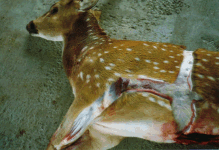Cape Removal
Removing the Cape and Head Skin
Make sure you check out the photos of how to remove a cape correctly.
Print this page for future reference!
Before you begin, take a few moments to assist the taxidermist achieve the correct appearance for your trophy.
- Measure the distance from the corner of the eye to the nose.
- Measure the distance form the nose to the brow line on the L.H.S
- Measure the distance from the nose to the trez tine or the bez tine on the L.H.S
- Measure the distance from the nose to the centre of the skull between the antlers.
Then remove the cape and the head skin. Make a Y shaped cut back from the antlers or horns; the cuts should meet just above a line between the ears, and centre of the back of the skull.
Make your back cut starting from the junction of the Y cut. Keep to dead centre of the back line and cut all the way until you are opposite the end of the brisket. (This is the point you stop your cut, when opening the animal up to remove the gut.)
Then complete a cut starting from the end of the brisket and completely encircles the animal, intersecting the back cut.
The next cut is to take the cape off from the knee joint , make a cut completely around the knee. now cut up the back of the leg and up past the armpit three to four inches, then cut back towards the rear of the animal, this cut must be parallel to the brisket. At no time cut down towards the brisket.
Now carefully remove the skin. Leave no meat or fat on the skin. Skin up to the back of the head and detach from the body. Cut the ears off close to the skull and continue to skin the Head skin off. Be careful and take your time. Once the head skin is off roll the lips out, open up the nose and invert the ears* (see note). (If you donít do this you will probably cause the epidermis, the layer of coloured skin inside the ears and around the eyes and nose to slip). Wash the skin in cold water, then gently wring out excess fluid. Hang up in a cool place to cool down for a couple of hours, then immediately freeze or salt the skin.
*Note if you are not experienced enough to do this and cannot get to a freezer for a day or so, heavily salt around the ears, nose, lips and eyes, inside and out, and freeze the animal as soon as possible. Flick the salt off before freezing and send it to your Taxidermist.
If you decide to freeze the skin immediately, do not salt it, simply fold it up and put it inside two freezer bags and freeze it. This should be done no later than six hours after the skin has cooled. The skin should be kept cool and transported to the freezer in a sack not in a plastic bag. Send to taxidermist when completely frozen.
Salting
If you decide to salt the skin rub in a generous amount all over the skin and either fold up and prop up on an angle to allow the fluids to drain or lay skin out flat on an angle. Remember to take special care salting around the eyes, ears, nose and mouth, rub the salt well in and pack inside the ears - you can never use too much salt. Keep it in the shade. After 24 hours remove the salt and put on a fresh batch, repeat this again in 48 hours. The skin will now last for months if kept in a cool sack. Send it to the tannery or Taxidermist as soon as possible .
*If you have decided to freeze the skin but canít get to a freezer for a day or so salt as above but remove the salt before freezing.
Pigs
Boars are caped by cutting up from the back of the knee joint on the front leg, up the back of the leg and up past the armpit area by three inches. Then back towards the rear and parallel to the brisket until youíre at least 12 inches past the rear of the front leg, preferably opposite the end of the brisket. Do the same on the other leg. Now make a circular cut from the end of this cut completely around the animal. Next skin the cape forward all the way to the nose, invert the ears and flesh off as much of the fat and shoulder pads as possible. Salt the cape heavily as above. Some hunters also make a back cut to finish about 4 inches back from the top of the head. A mount without the back cut is usually much neater in appearance.
Step 1
|
Step 2
|
Step 3
|
Step 4
|
Step 5
|

|
